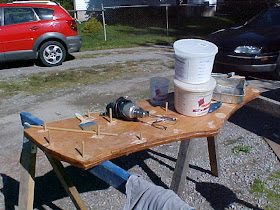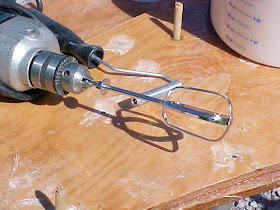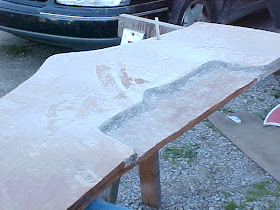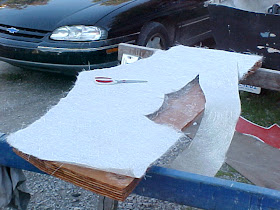
I figured there just may be a slim chance of having one or two more days left in the year peaking above the 65 degrees would I needed for one more day of
fiberglassing. I had waited a little longer before cleaning up around the
Batboat and putting things away for the winter.
One of those last warm days dawned on Saturday, October 11. I was checking with Weather.com every day and it finally predicted that the weekend was going to warm up so I made plans for the last
fiberglassing of the year.
What I wanted to do was more transom work with what little polyester resin was remaining and start on the Shark, Whale, Manta-Ray and Barracuda Marine Repellent cans.
 Anticipating
Anticipating this day, I added one more item to my arsenal; a stainless steel electric mixer spindle. I got this handy tip from
Oops! at the
iboats.com forum's Boat Restoration and Building section. These are used on a drill to blend fiberglass resin more efficiently with its hardening catalyst and also with thickening agents like wood flower and
cabosil.
I found a myriad of them at the Salvation Army. This was the longest one they had and it was priced around $.55.
I didn't have more than 3 quarts of polyester resin left so I set out to fill in and smooth out the low areas of the transom inside the boat and also a part of the transom plywood that would hold standing water.
I organized all the tools and everything else I needed for the work that morning and had it all ready, however, condensation and morning dew doesn't dry up and disappear until after 12 noon. That gave me a lot of time to think things over.

These were some of the large holes that are now made water tight with the 1.5 oz. chopped mat strand fiberglass cloth I laminated to the transom. [see
Batboat Rebuild: Day 14 September 27, 2008]
As you can see, they are low spots in the fiberglass need to be filled it. If left the way they are, there will be air gaps between the hull and the new transom plywood after I laminate the plywood in. This is where the motor goes. Structural weak points.
The best way to fill in and smooth these out is with "Peanut Butter", a mixture of polyester resin, wood flower and
cabosil, then grind it down flat after it sets. Called "peanut butter" because it has similar looks and
consistency.

I forget what I used and how much of it but if I recall correctly it was one pint of polyester resin with a little more catalyst than needed, two handfuls of wood flower and one of
cabosil.
First, I mixed the polyester resin with catalyst for one minute with the mixer then added the wood flower and
cabosil until it was all blended in.
This was the first time I ever made this and was worried that the Peanut Butter would begin to harden before I could use it all up. The opposite happened because it took longer to set than without the thickeners.

The Peanut Butter I made was more like a thick pudding but it still worked great. With my
spackling knife I glopped the mixture into all the uneven spots on the boat's transom area. Some of it had to be worked it back up after oozing down but in the warm sun it started to solidify enough so I quickly turned to the transom plywood.

Here is a potential problem area on the new transom ply I made. A shape had to be cut into it to allow room for the
splashwell. This will be laminated into the
Batboats transom which leans back about 15 degrees creating a pocket where water can collect and sit, eventually cause rot. The solution is to fill it all in at an angle.
 I used a Lowe's paint stirring stick I found in their parking lot as a trowel on the thickened poly resin
I used a Lowe's paint stirring stick I found in their parking lot as a trowel on the thickened poly resinIt wasn't as thick as I needed it to be and, as a result, was difficult at first to get all the Peanut Butter to stay in place. However, as the minutes passed the mixture began to jell stiffer making it easier to keep its shape.
After I glopped as many layers on as I could I quickly
spackled the rest of the mixture to the already curing areas inside the boat.
There were also several dowels that were loose in the ply so I pulled them out, filled the holes in with Peanut Butter and hammered them back in.
The dowels fill in where the later removed wood screws were used to clamp the two pieces of transom plywood together.
While I was waiting for all this resin to harden I grown down the already solid dowels flush to the plywood surface and took a break.
 Thickened "Peanut Butter" polyester resin hardening in the warm sun
Thickened "Peanut Butter" polyester resin hardening in the warm sun
Every area I filled in had cured completely solid. Its time to grind it all down smooth so I can laminate 1.5 oz chopped mat strand cloth on it.
 the grinder made everything nice and smooth
the grinder made everything nice and smoothAll low spots are completely filled in. Rough spots ground smooth. I cleaned the resin dust off the ply with a rag shirt soaked with Acetone and let it evaporate. Its ready for fiberglass cloth.

Here is one of the pattern shapes I cut weeks before. I am going to laminate this to the transom plywood to make it water proof. But first I need to cut out the
spashwell area so I can lay that in easier.

I mixed up a pint of resin and wetted on a thick layer with a paint brush to the ply so the fiberglass cloth will soak it in good.
 fiberglass cloth roller
fiberglass cloth roller
The picture above is the tool you'll need to work out all the air bubbles out of, and work resin into, the fiberglass cloth.
Air pockets are weak spots in lamination. The little ridges are key to working the resin in and bubbles out.
It was put to good use today because I had a lot of problems with the cloth not laying flat along the curves and edges of the splash well area but as the resin started to jell it worked out great.
I have two rollers, one that is big for the larger areas and a smaller one for tight spots. I think I used both on this day.
After the transom plywood was wet down with resin I laid the fiberglass cloth on top and quickly worked it down with the roller, alternately spreading more resin thickly on top. I didn't have enough mixed and
hastily made a couple more pints to spread on while working out the bubbles, making sure that the fiberglass was saturated and laminating completely in contact with all curved surfaces.
By this time my hands were sticking to everything and strands of fiberglass were everywhere. Yep, I went without the gloves this time because they had become covered with sticky fiberglass strands making it impossible to do anything in them.
Later, I found the glass was easier to get off my skin than the gloves and didn't burn at all. Even got some in my wounded finger!
 Top surface is now completely water proof. The other side gets fiberglassed next year when it is installed in the Batboat. I didn't have enough time or polyester resin left to do both sides. Ordering more would have taken five business days for delivery and by then who would know what the weather would be like?
Top surface is now completely water proof. The other side gets fiberglassed next year when it is installed in the Batboat. I didn't have enough time or polyester resin left to do both sides. Ordering more would have taken five business days for delivery and by then who would know what the weather would be like?
While the finished fiberglass job was setting I began to grind the inside transom smooth and it turned out perfect!

I started clean up and also the task trying to get all the fiberglass strands off my hands, tools and everything else it stuck to, then took a break.
After admiring the way everything turned out so well I started to make the Marine Repellent cans but I will save that subject for later, along with my utility belt project, with its own blog section.
the real deals....compared with....my repellents shown here halfway through painting
With all of that day's progress and momentum it was disheartening after I tried to think a way around two major problems; [1] The amount of time it would take for a new polyester resin shipment to arrive if I ordered more so I can complete the hull's transom repair and [2] the unpredictable weather.
I knew the weather was going to be too cold so I didn't risk ordering more the weeks before. Today's work was done in Michigan unpredictable fall months. You'll never know how it is outside from one day to another.
Which would have come first? If I ordered four gallons would it arrive before or after the temp dropped below curing temp?
With regret and some
frustration I realized again what I had known for more than a couple of weeks. I was through for the year.
If there were just three or four more days of good weather after the resin arrived I could be finished with the transom and may even have the stringers glassed in. If not, I would be stuck with expensive chemicals ($37+ per gallon) that may jell before I have the chance to use them next spring.
There is where I am at with the
Batboat project.
It is completely snug under the tarp as I put plans away for the spring weather. All the plywood, tools, and nearly twice the amount of various fiberglass cloths needed is here and ready to go, too.
:)




































